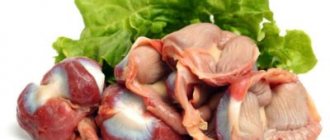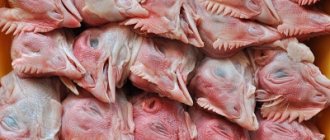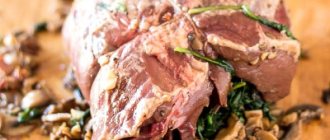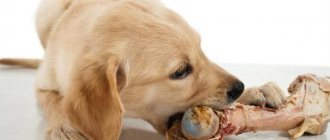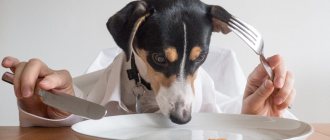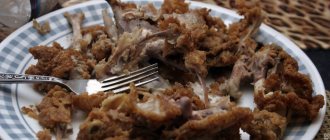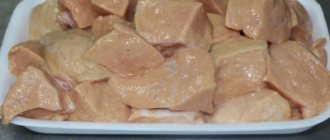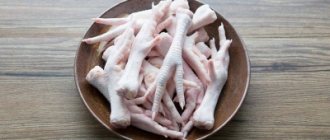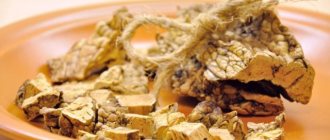When getting a four-legged friend, the owner wants the animal to live a long and happy life, have excellent health and an attractive appearance. The basis of all this is proper balanced nutrition that can provide all the necessary substances without causing harm.
If the dog eats dry industrial food from the very beginning, then it is quite easy to choose a diet for him, but if the owner prefers a natural menu, it is more difficult to correctly create a diet.
The basis of a healthy diet for a dog is meat , but you won’t be full with it. It is very useful to dilute the diet with a variety of offal, among which chicken gizzards remain one of the most popular.
This affordable, healthy and easy-to-prepare product will help diversify the diet of both an adult dog and a very young puppy, however, there are small nuances here too.
Benefit
Chicken gizzards are very healthy and nutritious for dogs. They contain 20% complete protein. Fiber, which is part of the offal, improves digestion, serves as a natural sorbent and maintains healthy microflora in the intestines.
Chicken gizzards contain a large amount of useful substances and vitamins necessary for the full functioning of the animal: iron, potassium, calcium, phosphorus, zinc, riboflavin, niacin, ascorbic and folic acid.
Another undoubted advantage of this product is its low calorie content (150 kcal/100 g), due to which it is considered dietary.
Eating chicken gizzards will help the animal maintain healthy skin, increase immunity, and support the digestive and circulatory systems. The fur of dogs that eat this by-product has a distinct color and shine.
Can all breeds be given
Large breeds: shepherd dogs, mastiffs, bulldogs and others can easily cope with any type of meat, including fairly tough chicken gizzards.
Small breeds (Pekingese, Yorkshire terriers, Spitz) are given only well-cooked and ground ventricles.
The jaw structure of these types of dogs and the size of the teeth do not allow them to cope with large pieces of tough muscle meat; untreated stomachs are difficult to digest, and there is a high likelihood of developing digestive disorders.
Harm and allergies
Eating chicken gizzards in large quantities is harmful to the health of the animal, as it can lead to diarrhea. It is also dangerous to feed your pet offal that has expired, as the resulting toxins can poison the body.
In rare cases, dogs may develop an allergy to chicken protein, which can be recognized by the following symptoms:
- An unpleasant odor appears from the mouth.
- The dog itches often.
- The animal's hair falls out in places and bald spots appear.
- A rash appears on the skin.
- There is excessive sweating.
In this case, consumption of the offal must be stopped and the animal must be shown to a veterinarian.
What parts of the carcass should you not give to your dog?
Your pet should not eat tubular (hard, hollow) bones or skins. The skin of chickens or turkeys is also contraindicated - these raw materials contain fat that negatively affects health. Bird skin is not introduced in any form, because it has a bad effect on the functioning of the intestines and liver.
The skin of pigs or cows is a source of intestinal parasites that are dangerous for your pet. Tubular bones cause damage to teeth, and their fragments injure the esophagus. Eating prohibited bones causes suffocation and can lead to the death of a friend.
How to give?
Chicken gizzards can be given to your dog as an independent food product or added to porridge, broth, or vegetables. The share of offal in the dog menu should be no more than 15%.
The consumption rate for an animal is 2 times a week. It is possible to give your pet offal every day, but then the portions should be minimal.
Raw
It is not recommended to give raw stomachs to dogs. Even if the product has been deep frozen, there is a risk of contamination by parasites. Before consumption, the offal must be subjected to heat treatment - boiled or stewed.
What by-products can be given to a dog: allowed products and how to prepare them
Using tripe will not only diversify the menu, but also enrich the body with essential substances. They use different parts of the carcass, boiling them or offering them raw.
Avian
Bird carcass parts are a cheap and nutritious food. They contain a lot of collagen and protein. However, poultry offal rarely provokes allergic reactions.
Hearts, liver and stomachs
Chicken or duck liver contains vitamins A and B12. Heart tissue and ventricles of birds are an excellent source of protein. They include zinc, iron, collagen. They should be offered to four-legged animals only in boiled form, no more than 2 times a week.
Too much vitamin A worsens bone health and reduces muscle mass. Heat-treated liver is added to porridge or used to make soup.
Necks, heads and paws
These parts are a favorite treat for your pet. In addition, the necks, heads and paws saturate the pet with calcium, phosphorus, collagen and elastin.
Broth or jellied meat is prepared from chicken feet to feed puppies. The necks and heads make healthy soups and porridges. They do not have hard bones and are easy to digest.
However, it is important to remove their beaks and claws before feeding them. It is permissible to use poultry entrails without prior heat treatment.
Beef
Beef by-products are often used in dog menus. All parts of a cow carcass have a positive effect on the four-legged body, because they are a storehouse of vitamins and important elements. Beef udder, kidneys, heart and other innards are suitable for dogs.
Heart
The heart has a denser structure than meat due to the large amount of protein. It contains selenium, zinc, phosphorus, important amino acids, elastin and collagen. It is useful to use it raw, since heat treatment destroys a large proportion of the elements.
Scar
The rumen is a part of the cow's stomach that contains a lot of protein, enzymes, special bacteria and amino acids. These substances promote better digestion of food, neutralizing toxins and strengthening the dog’s immunity. Green tripe is considered the most useful.
Before treating your pet to a delicacy, the tripe is thoroughly washed. It is acceptable to eat raw and cooked organ. To remove the unpleasant odor, the tripe is frozen for two days.
Language
This is an expensive product, so it is rarely added to animal diets. The tongue is used both raw and processed. The chemical composition is similar to the spleen. Suitable for training the jaw muscles.
Spleen
An organ containing large amounts of protein, iron and amino acids. Before use, the spleen is boiled and given no more than once a week. An overabundance of the spleen causes diarrhea.
Udder
Beef udder contains a high percentage of fat, so it should not be used frequently in the menu. Abuse provokes digestive system disorders and allergic reactions.
In small quantities, the udder is useful during increased activity for building muscle tissue. It is boiled or served raw, after removing excess fat and cutting into small pieces. Veterinarians give recommendations on how long to cook beef udder for dogs: the cooking time takes 2-3 hours and depends on the age of the animal that will eat this product.
Beef brains
The brain contains many substances such as lipids and choline, which are useful to saturate the four-legged body with before the planned mating. In addition, brains are a nutritious product that can quickly satiate a pet. The brains are boiled before adding to the porridge.
Tails and cartilage
They have little protein, but an abundance of calcium and phosphorus. The tail and cartilage are a storehouse of useful amino acids and trace elements. Dogs of any age love to chew cartilage for a long time, so even puppies are allowed to eat them during the change of teeth. Veterinarians recommend the use of tails and cartilage without prior boiling.
Cheeks, nose, lips
These parts of the carcass are rich in protein and consist of highly digestible muscle tissue. Broths and jellied meat are prepared from them, suitable for feeding puppies or elderly animals. The main thing is to cut off excess fat from the surface of the raw material. The cheeks, nose and lips themselves are added to food in boiled and chopped form.
Lung
This organ is not rich in animal protein and has mainly connective tissue. Liver is poorly digested and absorbed, so it is not welcome in a dog’s diet. Eating lung can cause vomiting and intestinal upset. It is used only as an additive to the main meal in small quantities. For this purpose, the lung is boiled and cut.
Bovine testes
This is a real delicacy that four-legged animals really like. The testes contain very tender meat, suitable for feeding puppies, lactating females and weakened individuals. They are not recommended only for males who are about to mate in the near future - bull testes cause overexcitation of the male's nervous system and complicate mating.
Fresh parts of the bull are boiled for half an hour and then peeled off with a knife. After cooking the bovine testes, it is recommended to pour out the broth, and finely chop them before adding them to the porridge.
Liver and kidneys
These organs contain vitamins A, B12, which are essential sources of folic acid and strong antioxidants. The liver does not contain toxins and has a good effect on the functioning of the reproductive organs.
Use tripe no more than once a week. Thus, its volume in the diet should not exceed 5%. A large amount of liver and kidneys in the diet leads to disruption of the digestive system. Raw entrails are heat treated and cut into small pieces.
Pork
Pork liver and trimmings are quite fatty raw materials, so they must be introduced into food with caution. Excessive consumption of pork offal leads to obesity or the development of food allergies.
Heart
Pork heart is used in the diet only after fat has been removed from its surface. Consuming this organ increases your pet's stamina. The heart contains coenzyme Q10, which improves immunity and prevents aging of the body.
Selenium, zinc, phosphorus and beneficial acids help build the necessary muscle mass and maintain the required energy level. The structure of the heart resembles muscle tissue. It is allowed to introduce raw or cooked product into the dish.
Liver and kidneys
Eating them helps you get another source of vitamins A, B, folic acid and iron. All these substances stabilize the functioning of the nervous system, saturate cells with oxygen and participate in metabolism.
The liver is especially useful in the nutrition of lactating females and growing young animals. It is preferable to feed animals raw liver and kidneys. To prevent pets from becoming infected with worms, the insides are placed in the freezer for several days. Heat treatment is also possible, but it will significantly reduce the amount of useful elements.
Spleen
In terms of the presence of amino acids, the pork spleen is close to the liver and muscle meat - this organ contains a lot of protein and iron. Spleen is suitable for adults and elderly individuals.
Puppies are given a spleen only after 6 months. It should be added no more than once a week. The spleen is boiled for at least 2 hours, crushed and combined with porridge.
Ears and cartilage
This is a cheap raw material with a large number of elements, without which the proper development of bone and muscle mass is impossible. The trim trains the jaw well, cleans the teeth and massages the gums.
Before use, the ears and cartilages must be thoroughly cleaned of dirt using water or a knife and placed in the freezer for three days. Then they are treated with boiling water.
How to cook?
Frozen bird gizzards must be thawed before cooking. Next, rinse thoroughly in water, peel and cut into pieces.
Boil water in a saucepan, add a little salt. Dip the prepared navels into boiling water.
How long to cook?
You need to cook the offal for about 15 minutes. Then cool and you can feed the dog.
Baked
Chicken gizzards make excellent dog biscuits. To prepare it you need to take:
- 30 g vegetable oil;
- 200 g ventricles;
- 25 g tomato paste;
- 4 cups flour;
- 2 cups boiled rice;
- 4 tbsp. l. basilica
Grind the ventricles with oil, tomato paste and basil in a blender. Pour the mixture into a plate, add rice and flour, stir. Roll out the prepared dough and cut out cookies with cookie cutters. Bake in the oven on a baking sheet for 30 minutes. Cool and you can treat your favorite animal.
Fried
Frying chicken gizzards is not recommended for dogs. Any fried food is generally harmful for pets.
Chicken heads
Is it possible to feed your dog chicken heads? It is possible only for animals of large and medium breeds. Before giving a treat, it is necessary to pull out the beak, which can cause mechanical injury.
The most nutritious thing in chicken heads is the brain, which contains vitamin B12. Thanks to it, the pet builds muscle mass, feels vigorous and healthy.
In wet food
Wet dog food is easier to digest than dry dog food, which is why it costs more. There are two types of wet food:
- deli meat;
- normal diet.
The regular diet contains muscle tissue from birds and animals, grains and soy. It is more complete than deli meat food, which consists of offal, preservatives, soy, dyes and flavoring additives.
With frequent consumption of cheap gourmet food based on offal, animals can become addicted, and due to a lack of minerals, the dog develops a skeletal disease. Therefore, it is recommended to periodically alternate dry and wet food.
When choosing wet food, you must pay attention to the composition. The best product contains pieces of chicken stomachs, salt and water. It does not contain chemical components. It is clear that the cost of such food cannot be low.
It is best to feed your pet natural chicken gizzards purchased in a store or market, then they will be more beneficial. They are cheap and very easy to prepare. Low quality by-products are often used in wet food.
Sausages
The most controversial product for pets. On the one hand, dogs love sausages and are ready to follow any commands in the hope of a treat. On the other hand, the product, even in small quantities, can cause severe allergies, stomach pain and liver problems.
To avoid complications, choose a product:
- made from poultry meat (chicken or turkey);
- children's version of the delicacy - without monosodium glutamate and excess salt;
- Beef sausages without added pork fat.
These types of meat products are less harmful. Cut into small pieces and used as a reward from time to time, they will not harm your pet, but will allow you to quickly advance in training.
Dried treats
Dried offal is a real treat for four-legged friends. They love to chew on it, which is good for their teeth. Treats are used as a reward when training dogs.
Dried stomachs retain all the beneficial vitamins and substances a dog needs. The animal's stool normalizes, the condition of its coat improves, and its immunity increases. The dried treat is very convenient to take with you on the road.
When choosing dry chicken gizzards, you need to pay attention to the natural composition of the product. Chemical additives are harmful to dogs. It is also necessary to take into account the age of the animal for which the treat is intended. To avoid health problems, you should not give your dog dry chicken gizzards in large quantities.
Dried dog treats can be purchased at pet stores or online stores. They are produced under the brands “GreenQZin”, “TiTBiT”, “DeliBest”, “Best-in”, “Stewart”, “For Dogs”, etc.
Recipe
Dried chicken gizzards can be prepared at home. To do this you need:
- Wash the chicken gizzards and cut into pieces.
- Place on an oven rack or baking sheet (place a container under the rack to drain the liquid).
- Dry for 5 to 8 hours at a temperature of 70 degrees, opening the oven door slightly to ventilate moisture.
Well-dried pieces can be stored in a cardboard or plastic box without placing them in the refrigerator.
Which is better, pulp or offal?
Both chicken pulp and its by-products have sufficient nutritional value, only the meat is more dietary. But your four-legged friend may have his own preferences.
Ideally, it is necessary to give alternately the pulp and other parts in different versions, without giving preference to one thing.
For puppies
Chicken gizzards are low in calories and are easily digested by the body, so they can be given to puppies from five months.
Offal should be introduced into the diet gradually, adding small portions to the main diet. After cooking, it is recommended to grind chicken gizzards in a meat grinder. It is imperative to monitor the reaction of the puppy’s gastrointestinal tract.
Chicken necks
Is it ok to add chicken necks to a dog's food? Even for puppies. Necks are a source of calcium and protein. When this product is added to the diet, the animal massages the gums and receives all the necessary nutrients.
If desired, you can beat it with a kitchen hammer or grind it into minced meat. Everything should be in moderation, so give this product about twice a week. If the necks are boiled and given in large quantities, intestinal obstruction may occur.
